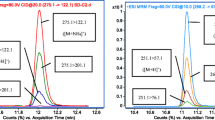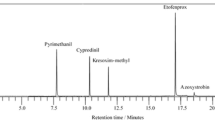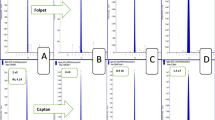Abstract
A multi-residue method based on modified QuEChERS (quick, easy, cheap, effective, rugged, and safe) sample preparation, followed by liquid chromatography tandem mass spectrometry (LC-MS/MS), was developed and validated for the determination of three selected fungicides (propiconazole, pyraclostrobin, and isopyrazam) in seven animal origin foods. The overall recoveries at the three spiking levels of 0.005, 0.05, and 0.5 mg kg−1 spanned between 72.3 and 101.4 % with relative standard deviation (RSD) values between 0.7 and 14.9 %. The method shows good linearity in the concentrations between 0.001 and 1 mg L−1 with the coefficient of determination (R 2) value >0.99 for each target analyte. The limit of detections (LODs) for target analytes were between 0.04 and 1.26 μg kg−1, and the limit of quantifications (LOQs) were between 0.13 and 4.20 μg kg−1. The matrix effect for each individual compound was evaluated through the study of ratios of the areas obtained in solvent and matrix standards. The optimized method provided a negligible matrix effect for propiconazole within 20 %, whereas for pyraclostrobin and isopyrazam, the matrix effect was relatively significant with a maximum value of 49.8 %. The developed method has been successfully applied to the analysis of 210 animal origin samples obtained from 16 provinces of China. The results suggested that the developed method was satisfactory for trace analysis of three fungicides in animal origin foods.

Schematic representation of the proposed residue analytical method for animal origin foods using QuEChERS and LC–MS/MS


Similar content being viewed by others
References
Walorczyk S, Drozdzyński D, Kowalska J, Remlein-Starosta D, Ziółkowski A, Przewozniak M. Pesticide residues determination in Polish organic crops in 2007–2010 applying gas chromatography–tandem quadrupole mass spectrometry. Food Chem. 2013;139:482–7.
Fernandez-Alvarez M, Llompart M, Lamas JP, Lores M, Garcia-Jares C, Cela R, et al. Simultaneous determination of traces of pyrethroids, organochlorines and other main plant protection agents in agricultural soils by headspace solid-phase microextraction–gas chromatography. Chromatography A. 2008;1188:154–63.
Xue N, Xu X, Jin Z. Screening 31 endocrine-disrupting pesticides in water and surface sediment samples from Beijing Guanting reservoir. Chemosphere. 2005;61:1594–606.
Komatsu E, Vaz JM. Parameter optimization for pesticide multiresidue determination using SPME in water samples. Nova. 2004;27:720–4.
Fenik J, Tankiewicz M, Biziuk M. Properties and determination of pesticides in fruits and vegetables. Trends Anal Chem. 2011;30:814–26.
Park JY, Choi JH, El-Aty AM, Kim BM, Oh JH, Do JA, et al. Simultaneous multiresidue analysis of 41 pesticide residues in cooked foodstuff using QuEChERS: comparison with classical method. Food Chem. 2011;128:241–53.
Golge O, Kabak B. Evaluation of QuEChERS sample preparation and liquid chromatography–triple-quadrupole mass spectrometry method for the determination of 109 pesticide residues in tomatoes. Food Chem. 2015;176:319–32.
Filho AM, Santos FN, Pereira PA. Development, validation and application of a method based on DI-SPME and GC– MS for determination of pesticides of different chemical groups in surface and groundwater samples. Microchem J. 2010;96:139–45.
Valera E, García-Febrero R, Pividori I, Sánchez-Baeza F, Marco MP. Coulombimetric immunosensor for paraquat based on electrochemical nanoprobes. Sens Actuat B. 2014;194:353–60.
Ewa S, Anna K, Aneta M, Magdalena P, Julian R, Magdalena SB. Evaluation of pesticide residues in fruits and vegetables from the region of south-eastern Poland. Food Contr. 2015;48:137–42.
Lozowicka B, Kaczynski P, Paritova AE, Kuzembekova GB, Abzhalieva AB, Sarsembayeva NB, et al. Pesticide residues in grain from Kazakhstan and potential health risks associated with exposure to detected pesticides. Food Chem Toxicol. 2014;64:238–48.
Weber CI, Muresan GH, Georgescu B. Organochlorine pesticide residues analysis from cow milk: a review. Animal Sci Biotechnol. 2008;65:43–8.
Leeman WR, van den Berg KJ, Houben GF. Transfer of chemicals from feed to animal products: the use of transfer factors in risk assessment. Food Addit Contam. 2007;24:1–13.
Stanisław W. Validation and use of a QuEChERS-based gas chromatographic-tandem mass spectrometric method for multiresidue pesticide analysis in blackcurrants including studies of matrix effects and estimation of measurement uncertainty. Talanta. 2014;120:106–13.
Łozowicka B, Jankowska M, Kaczyński P. Pesticide residues in Brassica vegetables and exposure assessment of consumers. Food Contr. 2012;25:561–75.
Zhao L, Lee HK. Liquid-phase microextraction combined with hollow fiber as a sample preparation technique prior to gas chromatography/mass spectrometry. Anal Chem. 2002;74:2486–92.
Cervera MI, Medina C, Portolés T, Pitarch E, Beltrán J, Serrahima E, et al. Multi-residue determination of 130 multiclass pesticides in fruits and vegetables by gas chromatography coupled to triple quadrupole tandem mass spectrometry. Anal Bioanal Chem. 2010;397:2873–91.
Cho SK, Abd El-Aty AM, Jeon HR, Choi JH, Shin HC, Shim JH. Comparison of different extraction methods for the simultaneous determination of pesticide residues in kiwi fruit using gas chromatography-mass spectrometry. Biomed Chromatogr. 2008;22:727–35.
Del Castillo ML, Rodriguez-Valenciano M, de la Peña Moreno F, Blanch GP. Evaluation of pesticide residue contents in fruit juice by solid-phase microextraction and multidimensional gas chromatography coupled with mass spectrometry. Talanta. 2012;89:77–83.
Cho SK, Abd El-Aty AM, Park YS, Choi JH, Khay S, Kang CA, et al. A multiresidue method for the analysis of pesticide residues in polished rice (Oryza sativa L.) using accelerated solvent extraction and gas chromatography and confirmation by mass spectrometry. Biomed Chromatogr. 2007;21:602–9.
Nguyen TD, Yu JE, Lee DM, Lee GH. A multiresidue method for the determination of 107 pesticides in cabbage and radish using QuEChERS sample preparation method and gas chromatography mass spectrometry. Food Chem. 2008;110:207–13.
Walorczyk S. Gas chromatographic–tandem mass spectrometric analysis of pesticides residues in produce using concurrent solvent recondensation–large volume injection. J Chromatogr A. 2012;1222:98–108.
Dong F, Chen X, Liu X, Xu J, Li Y, Shan W, et al. Simultaneous determination of five pyrazole fungicides in cereals, vegetables and fruits using liquid chromatography/tandem mass spectrometry. J Chromatogr A. 2012;1262:98–106.
Lehotay SJ, Ae Son K, Kwon H, Koesukwiwat U, Fu W, Maštovská K, et al. Comparison of QuEChERS sample preparation methods for the analysis of pesticide residues in fruits and vegetables. J Chromatogr A. 2010;1217:2548–60.
Zhang F, Wang L, Zhou L, Wu D, Pan H, Pan C. Residue dynamics of pyraclostrobin in peanut and field soil by QuEChERS and LC-MS/MS. Ecotoxicol Environ Saf. 2012;78:116–22.
Ahmad H, Vincenzo LG, Pierluici C, Giorgia S, Paolo C. Minor crops for export: a case study of boscalid, pyraclostrobin, lufenuron and lambda-cyhalothrin residue levels on green beans and spring onions in Egypt. J Environ Sci Health B. 2010;45:493–500.
Bart AF, Carlos B, Sarah A, Hans JC, John AL, Marco WF. Risk assessment studies on succinate dehydrogenase inhibitors, the new weapons in the battle to control Septoria leaf blotch in wheat. Mol Plant Pathol. 2012;13:263–75.
Antonio AF, Eric CA, Josep VM, Consuelo A, Antonio AS, Francesc AET. Determination of succinate-dehydrogenase-inhibitor fungicide residues in fruits and vegetables by liquid chromatography-tandem mass spectrometry. Anal Bioanal Chem. 2015;407:4207–11.
Fernandez M, Pico Y, Manes J. Analytical methods for pesticide residue determination in bee products. Food Prot. 2002;65:1502–11.
Walorczyk S, Drożdżyński D, Kowalska J, Remlein-Starosta D, Ziółkowski A, Przewoźniak M, et al. Pesticide residues determination in Polish organic crops in 2007–2010 applying gas chromatography-tandem quadrupole mass spectrometry. Food Chem. 2013;139:482–7.
Qin Y, Zhao P, Fan S, Han Y, Li Y, Zou N, et al. The comparison of dispersive solid phase extraction and multi-plug filtration cleanup method based on multi-walled carbon nanotubes for pesticides multi-residue analysis by liquid chromatography tandem mass spectrometry. J Chromatogr A. 2015;1385:1–11.
Ferrer C, Martínez-Bueno M, Lozano A, Fernández-Alba A. Pesticide residue analysis of fruit juices by LC–MS/MS direct injection. One year pilot survey. Talanta. 2011;83:1552–61.
Bozena L. The development, validation and application of a GC-dual detector (NPD-ECD) multi-pesticide residue method for monitoring bee poisoning incidents. Ecotoxicol Environ Saf. 2013;97:210–22.
Kmellár B, Fodor P, Pareja L, Ferrer C, Martínez-Uroz M, Valverde A, et al. Validation and uncertainty study of a comprehensive list of 160 pesticide residues in multi-class vegetables by liquid chromatography–tandem mass spectrometry. J Chromatogr A. 2008;1215:37–50.
De Pinho GP, Neves AA, de Queiroz MELR, Silvério FO. Optimization of the liquid–liquid extraction method and low temperature purification (LLE–LTP) for pesticide residue analysis in honey samples by gas chromatography. Food Contr. 2010;21:1307–11.
Mol HG, Plaza-Bolanos P, Zomer P, de Rijk TC, Stolker AA, Mulder PP. Toward a generic extraction method for simultaneous determination of pesticides, mycotoxins, plant toxins, and veterinary drugs in feed and food matrixes. Anal Chem. 2008;80:9450–9.
Lozano A, Rajski Ł, Belmonte-Valles N, Uclés A, Uclés S, Mezcua M, et al. Pesticide analysis in teas and chamomile by liquid chromatography and gas chromatography tandem mass spectrometry using a modified QuEChERS method: validation and pilot survey in real samples. J Chromatogr A. 2012;1268:109–22.
Acknowledgments
This work was supported by the Institute for the Control of Agrochemicals, Ministry of Agriculture, China.
Author information
Authors and Affiliations
Corresponding author
Ethics declarations
Conflict of interest
The authors declare that they have no competing interest.
Rights and permissions
About this article
Cite this article
Mu, Z., Feng, X., Zhang, Y. et al. Trace analysis of three fungicides in animal origin foods with a modified QuEChERS method and liquid chromatography–tandem mass spectrometry. Anal Bioanal Chem 408, 1515–1522 (2016). https://doi.org/10.1007/s00216-015-9260-7
Received:
Revised:
Accepted:
Published:
Issue Date:
DOI: https://doi.org/10.1007/s00216-015-9260-7




